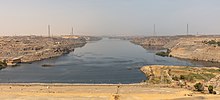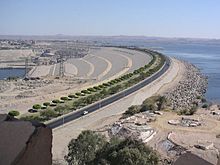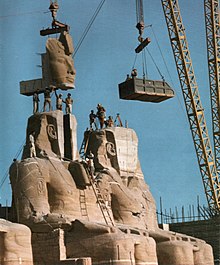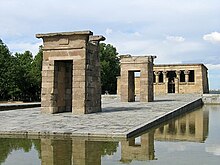Aswan dam
The Aswan Dam or Aswan Dam is a mega-construction projected in 1956 and built between 1959 and 1970 by the Egyptian and Soviet governments to end the floods that they occurred in the territory of the lower Nile as a result of the sudden increase in the flow of the Nile. President Gamal Abdel Nasser was responsible for promoting its construction and bringing the project to a successful conclusion. To do this, he showed a great capacity for political maneuver during the cold war. Thus, when the Americans withdrew their initial support for the dam project, he knew how to reconcile interests with the Soviet Union, which sponsored a third of the total cost of the project, in addition to providing technical and constructive advice to finish the dam.
The city of Aswan, which gives its name to the reservoir, is located on the right bank of the Nile, next to the first cataract. Two dams have been built in this area: the new Aswan High Dam and the smaller and older Aswan Dam or Aswan Low Dam >. The Aswan Low Dam was built by the British. Completed in 1902, it was 30 meters high, could only store water for one year, and was routinely overwhelmed by floodwaters from the Nile. As Egypt's population grew and technology increased, both the desire and the ability developed. to fully control flooding and thereby protect and support farmland and its economically important cotton crop. With the greatly increased storage in the reservoir provided by the Aswan High Dam, flooding could be controlled and the water could be stored for later release for several years.
History of construction
The Nile overflowed its banks annually when waters from Uganda and Sudan flowed into the lower Nile in summer. Since Antiquity, these floods were the ones that turned the lands near the river into a fertile plain, ideal for agriculture, by leaving a sediment of nutrients and minerals in the soil, the silt.
However, the unpredictable alternation of the level of the floods entailed the loss of entire crops due to flooding or drought and the consequent famine in the population, for which it was considered necessary to build a dam that would regulate the level of the floods to protect farmland and cotton fields.
Lower Dam 1899-1902
Following the invasion and subsequent occupation of Egypt in 1882, the British began construction of the first dam on the Nile River. Construction was begun by the British in 1899 and completed in 1902. The initial design was 1,900 m long. long by 54 m high and it was soon discovered that it was inadequate, so its height was increased in two phases: from 1907 to 1912 and from 1929 to 1933.
The Aswan Low Dam was designed as a gravity dam with masonry buttresses; buttress sections accommodate numerous gates, which were opened annually to let through the flood and its nutrient-rich sediments, but without retaining any hydraulic storage. The dam was built with rubble masonry and lined with red granite ashlars. When it was built, the Aswan Low Dam was the largest masonry dam in the world. The design also included a navigation lock on the west bank, which allowed shipping to pass upriver to the second cataract, whereas land transport was previously required.
When the dam nearly burst its banks in 1946, it was decided that instead of increasing its height a third time, a second dam would be built five miles upriver.
In 1956 the Egyptian government of Gamal Abdel Nasser announced the construction of a new dam in Aswan, which posed a very serious threat to the Nubian monuments.
High Dam 1952-1960
After the revolution led by the Free Officers in 1952, the decision to build a new dam on the Nile River was adopted by the Revolutionary Council of Egypt, then headed by General Muhammad Naguib. Greco-Egyptian engineer Adrian Daninos.
Although the project began to take shape in 1952, it was in 1956 when the government of Gamal Abdel Nasser gave a definitive impetus to the construction of the Aswan High Dam. The ideas expressed by Gamal Abd al-Naser in The Philosophy of the Revolution (Falsafat al Tawra) reflected the egalitarian ideals of the urban middle class. In it he assured that the way forward "is that of political and economic independence." This was clearly reflected in the decisions adopted by the new regime between 1953 and 1957, emphasizing independence and the construction of a national State, in which the evacuation of British troops was one of the immediate goals, an objective that it was achieved after the agreement of 10 October 1954 between London and Cairo.
This ideology was embodied in a practical way in the construction of the Aswan High Dam, erected along with the Suez Canal as a symbol of independence from Egypt, an aspect that made the project of paramount importance for the Nasser government. However, the Egyptian refusal to join the Baghdad Pact and enter the orbit of influence of the capitalist bloc, led by the United States and Great Britain, led to an alteration of the Anglo-American strategy in the Middle East.
The American retaliation translated into economic pressure at a time when Nasser needed technical and financial help to launch the modernization of the country through the construction of the Aswan Dam.
Finally, on July 26, 1956, the refusal of the Americans and the British to participate in the financing of the great Aswan dam, a condition required by the World Bank to grant a loan requested by Egypt, triggered the nationalization of the canal. Suez, which on an economic level represented an important source of income for Egypt through Canal payments, and on a political level, the recovery of Egyptian sovereignty, favoring the rise of Nasser as an anti-imperialist hero and leader of the Arab nation.
Faced with this situation, and withdrawn funding from the United States and Great Britain, Nasser requested support from the USSR. The non-alignment of Egypt, the result of the Bandung conference of 1955, allowed the country to strengthen ties with the countries of the communist bloc and accept economic and technical aid from the USSR after the refusal of the United States to participate in the financing of the dam from Aswan.
In reaction to this move, the British, French and Israelis invaded Egypt in October 1956. The invading troops occupying the Sinai and canal zone were compelled by worldwide pressure and a United Nations resolution to retire only a few months later, in December 1956.
Later, in 1958, the USSR proceeded to provide support to the high dam project, in the midst of the Cold War for dominance in Africa, possibly paying a third of the cost of the immense stone and clay dam as a gift. Apart from this monetary aid, it provided technicians and heavy machinery and the design was carried out by the Russian institute Zuk Hydroproject.
Typology and characteristics
The Aswan High Dam, located at the geographic coordinates 23°58′11.57″N 32°52′41.46″E / 23.9698806, 32.8781833, in Egypt, is located 6.5 kilometers upriver from the old Aswan Dam and 850 kilometers south of Cairo. It is a dam of loose materials, made up of a clay core (to prevent water from seeping in), and covered by granite breakwater (which holds the dam in place by its own weight). It is 3,600 m long and 980 m wide at the base, 40 m wide at the top and 111 m high. Under maximum capacity conditions, it can output 11,000 m³ of water per second. It has additional emergency spillways for a volume of 5000 m³ and the Toshka channel, which links the reservoir with the Toshka depression. This reservoir, called Lake Nasser, is 480 km long and 16 km at its widest, with an area of 6000 km² and contains between 150 and 165 km³ of water. It flooded much of lower Nubia and over 90,000 people were displaced.
To exemplify its magnitude, Egyptian writers often proudly mention the fact that the materials used in the construction of the new dam reached 43 million cubic meters, the equivalent of seventeen times the size of the Great Pyramid of Giza. This comparison has symbolic significance for the Egyptians, as the late President Nasser frequently commented: "In ancient times, we built pyramids for the dead. Now we will build new pyramids for the living."
Arab Contractors began construction in 1960. The High Dam, or Al saad al Aali in Arabic, was fully completed on July 21, 1970; In the first stage, the reservoir, which was partially completed in 1964, began to be filled with the dam still under construction, reaching full capacity in 1976.
In 1960, the cost of the Aswan High Dam was estimated at 380 million Egyptian pounds, and it was expected to pay itself off within two to three years after its completion, based on a rate of internal return of 44 percent each year.
When the Aswan High Dam project was completed and officially opened in 1971, the final cost of the project reached 560 million Egyptian pounds. This figure included the construction of the dam, as well as related projects, mainly those for power generation and land reclamation and resettlement in Egypt and the Sudan.
Effects
The Aswan High Dam has had great benefits in terms of water storage, hydroelectric power production, and river flow control, thus providing Egypt with the potential for further agricultural and industrial development. However, its construction also had important consequences both socially and environmentally, causing the displacement of communities threatened by the rising waters of Lake Nasser or ecological impact on fauna, flora and also on the economy of the peoples who inhabited the banks of the Nile prior to the construction of the dam.
Agriculture
In Egypt, where 94 percent of the population lives on about 5 percent of the land, and the rest of the territory is a barren desert, the Aswan Dam was built primarily for water storage and raising of agricultural production.
In 1952, when the construction of the Aswan Dam was proposed, Egyptian society was in full economic transformation. The rapid increase in population, at a rate far greater than the growth of arable land, made it a rare commodity. Added to this, 6 percent of the owners owned 65 percent of the cultivated land, with 94 percent owning 35.4 percent of the total arable land. To address this imbalance between the rates of human reproduction and the production of arable land, the Egyptian Revolutionary Council looked to the Nile for a solution through the Aswan High Dam project, which seemed be an adequate remedy to feed the growing population of Egypt and raise the standard of living.
Thus, the Aswan High Dam has provided Egypt with one of the largest reservoirs in the world and a net increase in agricultural production. This increase has been clearly manifested in almost all crops, but especially in the cultivation of rice, whose total production, for example, increased by 50 percent between 1966 and 1974.
On the other hand, the Aswan Dam contributed favorably to increasing the area of land devoted to cultivation. To this end, it is estimated that by 1975 the dam had contributed to the creation of 912,000 feddans (one feddan equals approximately 0.42 hectares) of arable land, which which translated into the possibility of being able to produce up to three crops a year in contrast to a single crop prior to the Aswan Dam.
Electricity generation
The Aswan High Dam project was generally seen as very promising, especially in terms of increased electricity generation, which would promote the industrialization that Egypt had worked so hard to achieve since the time of Mehmet Ali in the 17th century. XIX.
Twelve Francis-type main generating units, each with a capacity of 175,000 kilowatts, were installed at the Aswan High Dam hydroelectric power station. The station's potential generating capacity is currently 2,100,000 watts, with a peak electrical output of 8 billion kilowatt-hours per year.
It is important to note that while the Aswan High Dam was conceived and built primarily for the purpose of irrigation and increasing arable land, at the time of its construction approximately 53 percent of the total National annual energy came from the Aswan High Dam, according to 1974 statistics, and allowing, for the first time, electricity connection in most Egyptian towns.
Rescue of archaeological heritage
The construction of the Aswan Dam involved the flooding of a vast territory where thousands of people lived and where some of the oldest temples in Egypt were located, including the Abu Simbel complex. This resulted in one of the largest archaeological salvage projects of modern times, attracting the worldwide participation of archaeologists whose motto of work was: "now or never".
The financial and technical resources to undertake the salvage operation of the archaeological remains in danger of being under the waters of the dam went beyond the means available to the Egyptian and Sudanese governments, which is why UNESCO carried out a request for international help to save the antiquities in 1960, through the International Campaign for the Safeguarding of the Monuments of Nubia, emphasizing that the archaeological heritage is truly the heritage of all humanity.
In this way, twenty-four of these monuments were located, excavated and moved to safer locations, such as the File, Kalabsha and Amada temples, or were donated to the countries that collaborated in the rescue, such as:
- The Temple of Debod to Madrid
- Dendur Temple to the Metropolitan Museum of Art in New York
- The Taffa Temple to the Leiden Antique Museum
- Ellesiya Temple to the Egyptian Museum of Turin.
The following were delivered to the National Museum of Sudan in Khartoum:
- The Temple of Ramses II of Aksha
- The Temple of Hatshepsut of Buhen
- The Temple of Jnum of Kumma
- The tomb of the Nubian Prince Djehuti-hotep of Dibeira
- The temples of Dedun and Sesostris III of Semna
- The columns of Faras Cathedral
- Part of the paintings of the Cathedral of Faras; the other part is at the National Museum of Warsaw.
Despite the great international effort to safeguard this archaeological heritage, it is undeniable that the Aswan High Dam caused a cultural loss caused by the flooding of lands known to be rich in antiquities and monuments of past civilizations, especially in the land of Nubia, which contained remains of a number of civilizations dating back to the Paleolithic period (120,000 BC–17,000 BC).
Resettlement of communities
As in the case of archaeological heritage, the construction of the Aswan High Dam brought about the need to relocate Egyptian and Sudanese Nubians from their homeland to a new site, as a result of the construction of the dam and the formation of its huge lake.
Lake Nasser flooded much of lower Nubia and 100,000 to 120,000 people were resettled in Sudan and Egypt. In Sudan, 50,000 to 70,000 Sudanese Nubians were relocated from the old town of Wadi Halfa and its surrounding villages. Some were relocated to a newly created settlement on the shore of Lake Nasser called New Wadi Halfa, and some were resettled approximately 700 kilometers south of the semi-arid Butana plain near the town of Khashm el-Girba, up the river Atbara.
In Egypt, most of the 50,000 Nubians were relocated three to ten kilometers from the Nile near Kom Ombo, 45 kilometers downriver from Aswan in what was called "New Nubia." Housing and facilities were built for 47 village units whose relationship to each other approximated that of "Old Nubia".
However, despite the fact that both the Egyptian and Sudanese governments planned to provide the relocated Egyptian and Sudanese Nubians with better living conditions and help them develop communities in the new locations, the experience of relocation and adaptation to the new environment was traumatic, constituting a drastic social cost to the dam, rather than a socioeconomic benefit to those relocated.
Control of water resources
The control of the waters of the Nile has traditionally aroused suspicions on the part of the countries involved in the management of its water flow. In the words of sir William Willcocks, the British engineer who designed the Aswan Low Dam, "Whoever controls Lake Victoria controls the fate of Egypt". Hence the construction of the Aswan High Dam in Egyptian soil and under Egyptian control served as a symbol of the country's political and economic independence.
Egypt and Sudan negotiated an agreement on the waters of the Nile in 1959, which aimed to use these waters in a way that was advantageous to both countries. However, the recent construction of the Grand Ethiopian Renaissance Dam has renewed the regional conflict for control of the Nile waters, altering the status quo maintained to date. This mega-infrastructure pits Egypt and Sudan against Ethiopia, given the latter's possibility of unilaterally controlling the flow of the Blue Nile, since Ethiopia does not recognize the 1959 agreements between Egypt and Sudan which stipulated the use and control of the Nile waters.
Environmental issues
The construction of the Aswan or Sadd al-Ali high dam, located in Upper Egypt and designed to modify the physical environment to control the flooding of the Nile and produce energy, had serious consequences for the fragile balance of the ancient ecosystem, especially because the engineers who designed it did not take into account the ecological impact that its construction would have on the fauna, flora and also on the economy of the peoples who inhabited the banks of the Nile.
Environmental consequences have centered around four main issues:
Filtration and evaporation of reservoir water
Water loss through filtration and evaporation is a major issue. In this regard, the 1977 annual review report prepared by the University of Michigan estimated a loss of water of 12.5 billion cubic meters, equivalent to 14 of the annual contribution of water in the reservoir. Mention the damage caused by the loss of flow of the reservoir due to the seepage of water into the aquifers adjacent to Lake Nasser.
Silt sedimentation
On the other hand, the decrease in water flow has implied a greater sedimentation of silt and fine particles in Lake Nasser, thus preventing the passage of the famous Blue Nile flood sediments, which have contributed throughout history to generate the alluvial soil of Egypt, generating an impact on agricultural productivity as well as a problem of soil degradation.
Increased salinity of the waters
Thirdly, there is concern about waterlogging and the level of salinity of the irrigated soil; the reduced flow of the river has caused the salty waters of the Mediterranean Sea to penetrate the ground along the coast near the mouth, causing the destruction and salinization of the Nile delta, decreased productivity in fisheries, emigration of marine animals when the salinity barrier was removed, the rise in the water table in the nearby vegas, pollution of the river caused by fertilizers, herbicides and pesticides, etc.
Increased risk of diseases
Finally, it is worth mentioning the problem of the threat of disease through the expected increase in the incidence of schistosomiasis. That's because agricultural irrigation canals and the shores of Lake Nasser are perfect habitats for disease-carrying animals, such as the malaria mosquito (Anopheles mosquito) and snails that spread the bilharzia parasite.
Contenido relacionado
Song of the Nibelungs
Hunt
Gulf war






